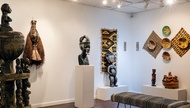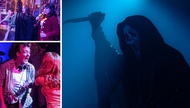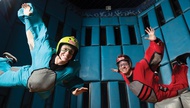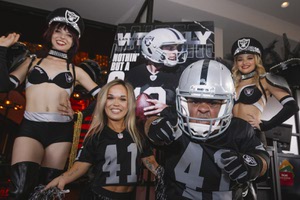At first blush, COVID-19 poses an existential threat to Las Vegas. The city evolved to lure humans to the desert, to gather in large numbers and to celebrate together. Those three simple elements have never faced a greater threat. The very idea of Las Vegas feels imperiled.
The future of Vegas entertainment
But this community’s ability to adapt, especially in the hardest of times, is unmatched. We relish innovation. It’s what we do.
These unpredictable times are a moment for rebirth and to reach new heights through bold visions rooted in the DNA of Vegas.
Imagine a flashing neon sign, maybe pink and blue, spelling out the words “Las Vegas.” It doesn’t matter when you last visited, or if you ever have, or if you’ve lived here your entire life. That image evokes feelings. It takes you somewhere.
Many people, including the current longest-running headliner on the Strip, will imagine a version of Vegas past. The decade doesn’t matter. The feelings are warm and comfortable yet exciting and glamorous. Las Vegas is about fun and freedom in this dream, but also the encouragement from knowing your hosts are taking great care of you.
“It was 24/7. You got up and had your breakfast buffet, then you went looking around town during the day,” Frank Marino says. “Maybe you’d gamble a while at another hotel. Then you’d come back to your hotel and get showered up and maybe gamble a little bit more before the show. Then you went to dinner. It was really Disneyland for grown-ups, something to do at every moment.
“And what I loved most was, if you were a high-roller and you walked through that casino or hotel, people would greet you by name and ask, ‘How are you?’ It was like family.”
Marino famously performed as Joan Rivers for nearly 25 years in An Evening at La Cage at the Riviera, which he fondly recalls as the first Strip resort to host two popular production shows; Splash ran in the theater next door for 21 years.
Live entertainment has always been at the center of the Vegas experience, the dazzling show that serves as the culmination of that 24-hour fun. It could have been La Cage or Splash, or a comedian or singer or bandleader performing in an intimate showroom or a wide-open lounge.
Marino’s all-time favorite Vegas act was Diana Ross at Circus Maximus, the 980-seat theater that opened in 1966 with Andy Williams and closed in 2000 after a final performance from Steve Lawrence and Eydie Gormé. Frank Sinatra, Ella Fitzgerald, George Burns, Aretha Franklin, Judy Garland, Milton Berle, Chuck Berry and Ray Charles are among the icons who played that room, before it was demolished to make way for the Colosseum and Celine Dion’s game-changing residency in 2003.
“I was so young then, I didn’t realize how cool it [was that] I knew Frank Sinatra, or the entire Rat Pack for that matter,” Marino says. “Sammy Davis Jr. was the first person to introduce me in the audience as a celebrity when I went to see him perform at the Dunes.”
In those days, he says, you’d go to a casino and buy a ticket for a show, then go back that night to see it. The initial ticket price for La Cage was $6.95, which included a prime rib dinner. After the show, you could duck into the lounge for some hot music; you might even catch one of the headliners hanging out at a booth in the back.
The feelings were spontaneous and exclusive, as if that particular night in Vegas would never happen again.
Images of the past remain vibrant and clear, while the future of Las Vegas entertainment has never been more uncertain. The Strip’s many shows, concerts and nightlife events have been shuttered for more than two months, disrupted by the coronavirus pandemic and the state’s closure of casino resorts. Although Gov. Steve Sisolak initiated Phase 1 of Nevada’s reopening plan ahead of schedule on May 9—allowing restaurants and other nonessential businesses to resume operations under certain restrictions—he has not set a date for when casinos might reopen.
On May 7, the Nevada Gaming Commission unanimously approved health and safety policies set forth by the Gaming Control Board, which casino resorts will be required to follow when they reopen to the public. Those guidelines don’t specifically address live entertainment venues like theaters and showrooms, but nightclubs and dayclubs within a gaming licensee’s property “must be closed until further notice.” Restaurants and other casino spaces will be restricted to 50 percent capacity. And in meeting and convention spaces, gatherings of 250 or more people will be prohibited until further notice.
That information confirms the obvious: The big shows and concerts that have dominated the modern Strip entertainment landscape will be among the final pieces to complete Vegas’ reopening puzzle. A large number of people working within close proximity and confined spaces is a requirement for many of the biggest productions. The sheer scale requires large audiences. Larger venues can be used safely with crowds under 250, but the economics for the large shows don’t make sense with small audiences unless ticket prices are higher than the market can bear.
It’s unknown exactly what measures will be required before large venues can reopen, but MGM Resorts’ Seven-Point Safety Plan—released on May 12—outlines physical distancing tools like no-touch ticketing, modified queuing and new food and beverage protocols with touchless points of sale and grab-and-go ordering and pickup. Frequent surface sanitization and enhanced cleaning protocols are also part of the plan at entertainment venues, and MGM will require its employees to wear masks and will “strongly encourage” guests to wear them and provide them upon request.
For now, when live performance returns, it will be presented in front of a much smaller audience with restrictive circumstances for an unknown transitional period.
And yet, that might make Las Vegas incredibly vital and exciting.
MGM Resorts International President and acting CEO Bill Hornbuckle said during an April 30 earnings call that the company might open its Bellagio and New York-New York properties first, that it’s unlikely T-Mobile Arena would host another major concert event this year and that comedian Carrot Top’s long-running show at Luxor is the type of entertainment event that might come online earliest.
“[That] was a great shocker. I love that they were thinking of us,” Carrot Top, aka Scott Thompson, says from his second home in Winter Park, Florida. “We’ve been talking a lot about Cirque [du Soleil] shows and how they have so many performers onstage interacting, and I’ve been saying to my team that we’re lucky—it’s just me onstage. [Entertainment] has been changing for a while, and shows have become bigger, with Cirque and [shows like] Aerosmith and Lady Gaga. Our show is still 350 seats.”
Thompson said he’s not aware of any plans to move his show to another MGM property that might open before Luxor, but added that his act “could definitely” work in another venue. Entertainment offerings will be constantly adjusting to whatever the new normal will be, which could see performers and audience members wearing face coverings, showgoers sitting six feet apart and entertainers keeping their distance from fellow cast and crew members.
But adapting to those new—and hopefully temporary—circumstances could accelerate a trend that had already planted its seed on the Strip. An innovative mix of live entertainment has sprouted up in smaller venues like restaurants, bars and clubs, and it’s colored with vintage Vegas vibes.
Carrot Top “absolutely went to those old shows and lounges” when he started performing in Las Vegas 25 years ago, before he launched his residencies at MGM Grand and Luxor. “I remember Cook E. Jarr & The Krums was a big deal. It felt like when you watch movies [about Las Vegas], it brought you back to that time and era. It’s completely changed now, but the lounge act was what Vegas was all about, and then also seeing Wayne Newton and Siegfried & Roy in [smaller] theaters. Remember Tom Jones at MGM? I used to go to that show three times a week. He’d see me in the audience and say, ‘Scott has been to my show more times than I have.’”
Marino sees that kind of entertainment coming “full circle. My opinion is, this will turn the clock back to the early 1980s, and it’s going to be the mom-and-pop shows, as I call them, which don’t need to make a million dollars a night to break even. That’s going to come back … to the forefront, because the stadium shows and sports arenas that have been taking people away from these showrooms are going to be down for a while, and the Cher, Britney, Lady Gaga, Celine Dion [residencies] are not coming back immediately.”
If you’ve ever wondered how and why Las Vegas entertainment got so big, the simple answer is music. The halcyon days of the Rat Pack might have ended in the ’60s and early ’70s, but free live music in casino lounges and headlining superstars in 1,000-seat showrooms continued to form the blueprint of Strip entertainment into the ’90s.
Once upon a time, Vegas didn’t have the venues to attract top-tier touring acts. When those big buildings finally arrived—Sam Boyd Stadium in 1971 and the Thomas & Mack Center in 1983—they weren’t on the Strip and weren’t originally created for concerts.
“Until the early 1980s, we probably would not have even been considered a B touring market,” says Pat Christenson, president of Las Vegas Events and author of Rock Vegas: Live Music Explodes in the Neon Desert. “The Las Vegas headliner tradition was different from touring headliners. The Rolling Stones, Neil Diamond, they weren’t playing here. The largest-capacity venues we had were at the Aladdin [opened in 1976] and the Convention Center, and while they got some acts, when those tours came here it was pretty small.”
The Thomas & Mack Center made the biggest impact. Christenson became event coordinator for the UNLV Athletic Department in 1980 and was promoted to assistant director of the brand-new, 18,500-seat T&M three years later, at the same time the university took over management of the 30,000-seat Las Vegas Silver Bowl (later renamed Sam Boyd Stadium).
Unlike the football stadium, UNLV’s shiny new basketball arena was developed with entertainment events in mind, mostly because its original funding couldn’t cover an increase in capacity during preconstruction. In its first year, the Thomas & Mack hosted concert tours from Van Halen, Rush, Lionel Richie, Waylon Jennings and Willie Nelson, The Beach Boys and dozens more. In its second year, the arena brought the National Finals Rodeo to Las Vegas. Meanwhile, the Grateful Dead, U2, Paul McCartney and the Eagles played the Silver Bowl.
In 1993, the MGM Grand Garden Arena arrived and completely recalibrated live entertainment on the Strip and in Las Vegas overall. Its initial purpose was to steal big boxing events from Caesars Palace, Christenson says, but after it opened with two sold-out Barbra Streisand concerts featuring an all-time-high Vegas ticket price of $1,000, touring concerts became the priority.
“When MGM Grand would bring in these big-name acts, not only would they sell out and do better than [previous Vegas shows], they had a higher ticket price,” Christenson says. “It was on the Strip and had the brand of the hotel and the city, [so] the whole entertainment offering was shifting.”
MGM Grand marked the beginning of Las Vegas as a true global entertainment destination. Other arena-size venues and massive theaters like the Colosseum at Caesars Palace, T-Mobile Arena and Park Theater at Park MGM would follow, and the musical superstars that began to visit the Strip for touring shows or headlining residencies had names as big as the city itself.
In early March, right before the COVID-19 crisis caused everything to shut down, Las Vegas was poised to have its biggest year of entertainment yet, combining multiple weekly megaconcerts along Las Vegas Boulevard with unique, large-scale production shows, summer and fall music festivals at different sites around the Valley—and the ever-expanding presence of pro sports with the opening of Allegiant Stadium and the debut of the Las Vegas Raiders.
“I think Vegas is going to go back to the intimate showroom and more value for your money, and both of those are things that lead to more connectivity with audience, [which is] really fantastic,” Adam Steck says. “I think this presses the restart button on many fronts.”
Steck’s company, SPI Entertainment, produces five shows on the Strip—Boyz II Men’s residency at the Mirage, Human Nature’s residency at Venetian and the trio of shows at the recently renovated, 425-seat Thunderland Showroom: Thunder From Down Under, The Australian Bee Gees Show and Hans Klok: The World’s Fastest Magician. Klok’s magic show, which opened last year, is the only one of the five that hasn’t already experienced many successful years on the Strip. The company’s cornerstone, Thunder From Down Under, was doing record business right before the shutdown and is already booking group reservations for future shows.
Because SPI shows take place at more intimate venues, operate with smaller casts and crews, and generally feature lower ticket prices than headlining residencies or production shows, they look well-positioned to continue their success. And Steck says that extends beyond the short-term, because even when casinos reopen and visitors begin returning to the Strip, they’ll likely have less money to spend in Las Vegas.
“For Vegas, this could be a cleansing,” he says. “Hopefully it can get rid of a lot of the greed that has set in and make it like it used to be, a value-driven place. Vegas has to be all things to all people, and as of late, it’s been veering toward [having] a good-sized wallet to come to town.”
Spiegelworld’s three comedy and circus act variety shows take place in venues with capacities below 600—Absinthe at Caesars Palace, Opium at the Cosmopolitan and Atomic Saloon Show at the Grand Canal Shoppes at Venetian. Company founder Ross Mollison says he plans to reopen all three productions when possible with modifications to their venues and schedules, but he doesn’t think the shows themselves will be altered much.
“We never end preproduction in our shows,” he says. “We’re always improving and looking for ways to maximize opportunities in every part of each show.”
Steck and Mollison agree that’s the approach every show on the Strip will have to take while moving through the reopening stage and the post-pandemic future. And they both say there will be space for live entertainment innovation, even if finances are reduced.
“It does feel like launching new stuff when nothing else is happening is a great idea,” Mollison says. “I think one of the key reasons why Absinthe stood out is, there was so little happening after Vegas cratered in 2009. There weren’t many [new shows], and that helped give us the chance for a great opening in 2011.”
With so much investment in big-room residency shows, companies like MGM Resorts, Caesars Entertainment, Live Nation and AEG Presents could team with their signature artists and rescale those endeavors. Imagine if Garth Brooks, still scheduled to perform the first concert event at Allegiant Stadium in August, resumed his 2009-2014 run at Wynn’s Encore Theater in front of an even smaller live audience while the show is streamed to Wynn and Encore’s hotel rooms for a reasonable fee. Or if Lady Gaga continued her acclaimed Jazz & Piano residency at Park MGM from the regal NoMad Restaurant, with guests at all MGM properties—or beyond—able to tune in.
Such a hybrid model could make the live audience experience unbelievably exciting—and worth a high ticket price—while the broadcast of each show could generate as much revenue as filling a large venue.
“I’ve tried numerous times to get artists like Sade to do something in a more intimate showroom with a super-high ticket price, because unless they’re guaranteed the money they’re used to making, in my experience it’s a no,” Steck says. “It would be amazing if somebody like Lady Gaga came in and reduced that fee and did her thing in a space like that. That could be an incredible experience.”
Jon Bon Jovi played a private acoustic show at the Absinthe Spiegeltent at Caesars in January for a crowd of fewer than 250 people. “There’s no reason we couldn’t do that again,” Mollison says.
“If Bon Jovi plays a giant arena and has 60 people traveling and a full band and everyone in their own bus, it’s a big deal—a lot of people to expose and monitor and very [expensive],” says Seth Yudof, founder of the Las Vegas-based production company UD Factory. “But he can do that show with just himself and a guitar for very little money, and he can still make a bunch of money.
“Think of Steven Tyler. He’s a major artist and you can get him by himself for much less money than Aerosmith, but he makes more. There’s a way to have a win-win depending on the production values.”
Prior to the coronavirus shutdown, Yudof was producing The Miss Behave Gameshow at Bally’s and Tenors of Rock at Planet Hollywood. He has also assembled limited engagements for Richard Marx and Keith Sweat at the Flamingo Showroom and Blues Traveler, CeeLo Green and Plain White T’s at Cleopatra’s Barge in Caesars Palace, so he’s accustomed to managing big acts in small rooms.
“I’m an entrepreneur, so I think there’s opportunity in all these changes. There were some problems in Vegas entertainment before all this started. This will probably accelerate some changes that might have taken a decade or two to work out, and now they might happen in the course of the next year or two,” Yudof says. “When you talk about smaller shows having an advantage or lounge-style entertainment coming back, those are great ideas we should be looking at. And they will rely heavily on the partnership between producers and casinos [in the immediate future], because the economics are going to change with that reduced capacity in venues.”
Coming out of the shutdown, Yudof says, there will be a huge opportunity for unticketed entertainment, not unlike the open lounges of the past, provided casino owners buy into the idea. “Louis Prima won a Grammy in 1958, and he was doing a free show at the Sahara at the time. And Wayne Newton had ‘Danke Schoen’ on the radio in the ’60s when he was playing six nights a week at the Fremont,” Yudof says.
Newton has played every size of venue imaginable, from T-Mobile Arena to his current home at the classic lounge Cleopatra’s Barge at Caesars Palace. He says the Strip’s resiliency has always depended on its ability to adjust.
“When entertainment does return, and it will, the customers will dictate what they can and can’t afford,” says Newton. “But since most shows are owned by independent producers rather than casinos, they have to be able to make a profit on their own. I have faith that casinos will support entertainment to help it get back to where it was, because what the world needs now is entertainment.”
Jason Gastwirth, President of Entertainment for Caesars Entertainment, reaffirms that commitment. His company has a diverse lineup of entertainment ranging from headliners at large venues to production shows at midsize rooms and acts like Newton at the Barge.
“We’re taking steps to create an appropriate environment, which our guests will hopefully enjoy,” Gastwirth says. “We’re in a great position to ramp up based on our guests’ preferences and government health-related directives. We already work very closely with our artists and show partners, and we plan to collaborate at an even higher level to restart this important part of the live entertainment industry.”
Two MGM properties were building phenomenal modern-classic offerings when everything stopped. Brian Newman After Dark, a jazzy late-night party centered around Newman, Gaga’s Jazz & Piano bandleader, was creating plenty of buzz and connecting old Vegas with the new at the NoMad at Park MGM. And Bellagio’s Mayfair Supper Club was seamlessly mashing up a glamorous fine dining experience with thrilling live performance and an energetic nightclub vibe in the later hours.
The essential similarity isn’t the style of the show; it’s the type of venue.
“Anytime you have professionals with expertise tasked with overcoming challenges as it relates to live entertainment, people are going to get creative and come up with solutions and workarounds,” says longtime Las Vegas nightlife executive Sean Christie. “Restaurants are prime candidates, if and when things open up over the next several months, for … interesting live entertainment [opportunities], because they have bigger spaces, indoor-outdoor spaces, and there probably won’t be enough visitor volume initially to [justify] operations for many casino restaurants.”
Christie helped build the stellar nightclub and dayclub portfolio at Wynn and Encore before spending the past few years as president of events and nightlife for MGM Resorts. The New Year’s Eve opening of Mayfair Supper Club was his last major project before he departed his post in March.
The creation of Mayfair wasn’t based on nightlife or dining trends in Las Vegas; it was inspired by the constant travel Christie and other execs undertook in order to create something familiar, yet different. Experiences that are becoming popular in major cities around the world—what Christie calls a mixture of performance, food and beverage and high design—could similarly inform the next stage of live entertainment on the Strip.
“That trend was definitely already here before the pandemic, and as a result of having to be creative, could be something the city leans into,” he says. “There were a lot of broken entertainment models [in Vegas], and everybody knew there needed to be a reset. Maybe it was something that would have been a slow closure, and now it’s just closed.
“What’s interesting is that the people that just closed or will close these shows or clubs or restaurants are going to be the same people that come up with the new ideas for these new circumstances and find ways for people to congregate,” Christie continues. “Initially, things will be set up to meet the immediate needs of safety and laws and regulations and just making people comfortable, but out of that there will rise these new cool things we haven’t even thought of yet.”
Whatever it is that takes us to the other side of the pandemic, it’s generally assumed Las Vegas will be Las Vegas once again, and those huge entertainment options will eventually return. There’s too much built here for it not to happen, and those experiences are all about feeling spontaneous and exclusive, and creating memories that visitors know won’t happen again.
“I don’t see a long-term paradigm shift,” Christenson says. “I’m a live music fan, so I know there’s a lot of pent-up demand, a lot of people sitting and watching things [on screens] they would have been going to.”
Christenson emphasizes how many new experiences were on the way for coming years, from Allegiant Stadium to the MSG Sphere to Resorts World. He says Vegas hasn’t seen its biggest shows yet.
“It’s an environment that fits all [the artists’] needs and where their fans come to them, and it’s safe,” Christenson says. After we get through this virus, I think you’ll see the full potential of that model.”
Until that unknown point in time, maybe it’s best to look to the past for a bit of inspiration and a lot of wisdom—and to trust the wildly creative minds that made the Strip the dynamic destination it is today.
“I think it’s time to dream,” Mollison says. “We can think about how it would look in a perfect world and what would we do if we could do it all again. We may not have capital to do those things soon, but at least we can lay the foundation for what we want to put in place for when our audiences return.”





